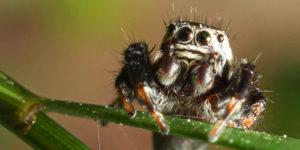Jumping spiders: small animals with a brave character
The most intelligent representative of arthropods is the jumping spider. The size of his brain is 30% of the cephalothorax. And the presence of 8 eyes opens a viewing angle of up to 360 degrees. These qualities make them excellent hunters.
Content
What does a horse spider look like: photo
Description of the racehorse family
Name: jumping spiders
Latin: SalticideClass: Arachnida - Arachnida
Squad: Spiders - Araneae
 | Habitats: | humid warm places |
 | Dangerous for: | small insects |
 | Attitude towards people: | harmless, harmless |
The body size of a jumping spider is up to 1 cm in length. Despite the small size, the jumps reach 20 cm. This property is associated with the lymphatic circulation system. Due to the jerky injection of hemolymph, an instantaneous hydraulic effect is formed.
The structure of the paws resembles a crab. Moves sideways with the help of tucked grouped legs. The length of the paws changes like a straightened spring after compression.
The eyes have several levels. They are arranged in 3 rows. The main 4 eyes have a full-fledged retina, which allows you to distinguish colors. Auxiliary eyes are responsible for light perception. The retina of the eye allows you to determine the distance in relation to any object.
The first half of the cephalothorax is distinguished by a strongly elevated position, the posterior half is flattened. The head and chest are divided by a shallow and transverse groove. The body also bears similarities to crustaceans. It has a square shape.
Coloring can be varied. Arthropods can imitate ants, beetles, false scorpions. But there are also bright, colorful animals.
Reproduction and life cycle
Almost all varieties have a kind of marriage ceremony. The mating dance of males consists in raising the forelimbs and hitting their body with a clear frequency. Females show a preference for males with longer pedipalps.
Habitat
Jumping spiders can live in a variety of places. Most species choose tropical forests. The habitats of some species are the temperate forest zone, semi-deserts, deserts, mountains. Homeland of the jumping spider:
- Southeast Asia;
- India;
- Malaysia;
- Singapore;
- Indonesia;
- Vietnam.
Jumping Spider Diet
thanks phenomenal vision and internal hydraulic system hunt during the day. This is facilitated by the ability to jump over long distances.
With the help of small hairs and claws, they overcome a horizontal glass surface. Spiders lie in wait for their prey and jump on it. They feed on small insects of any kind. At home, they are given Drosophila, green and black aphids.
Natural enemies
Arthropods have many enemies in nature. Of the most dangerous, it is worth noting spider birds, lizards, frogs, large insects, wasps riders. Wasps riders lay eggs in the body of a spider. The larvae eat the arthropod from the inside.
In the absence of food, these cuties are able to eat each other. The adults often eat the young.
Varieties of jumping spiders
Different species differ in color, size, habitat. Of the most common, it is worth noting a few prominent representatives.
Jumping spider bite
The spider has poison, but it is not able to penetrate the dense skin of people. Therefore, this type is absolutely safe. A person can easily pick it up.
Some exotic pet lovers keep jumping spiders at home. They are kept in containers with an optimal microclimate, comfortable temperature, and humidity.
There are a number of requirements for breeding spiders at home. You can read about them at the link below.
Conclusion
Jumping spiders are an important link in the ecosystem. They feed on mosquitoes and insects that are dangerous to plants. Thus, they help to keep many cultures whole and healthy for people.
